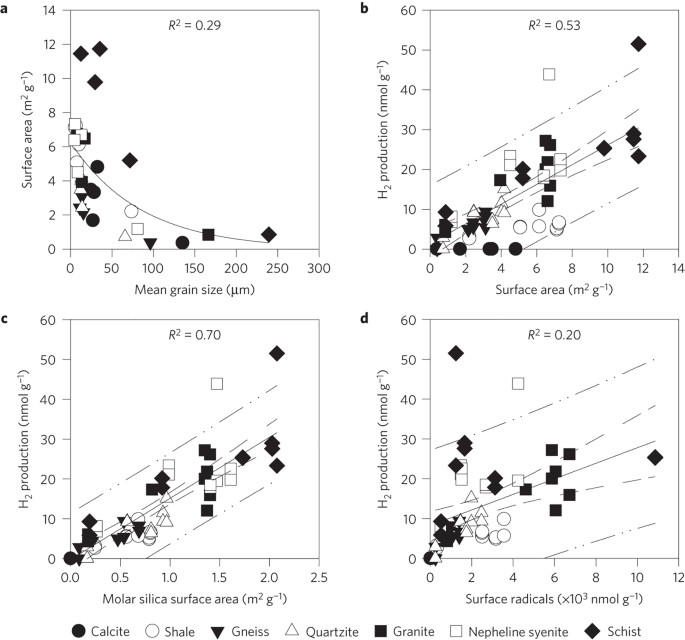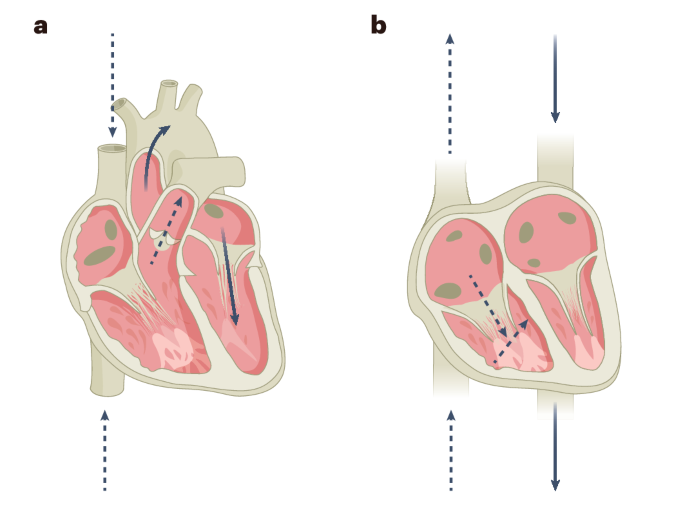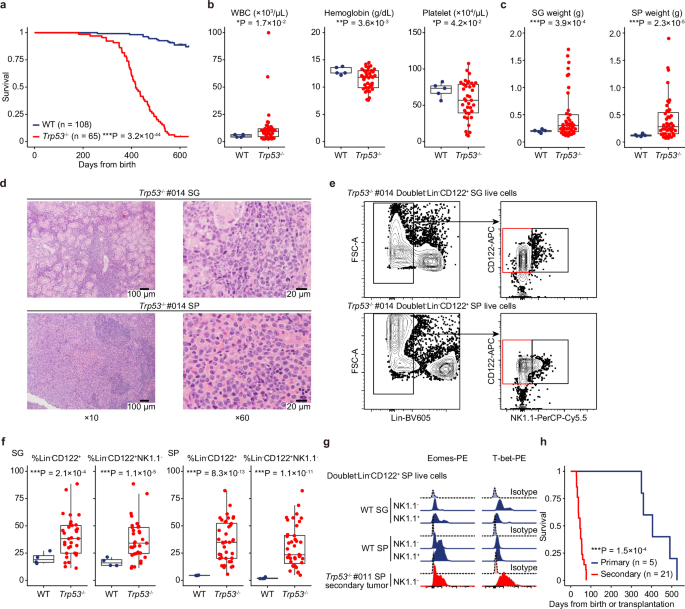
- Select a language for the TTS:
- UK English Female
- UK English Male
- US English Female
- US English Male
- Australian Female
- Australian Male
- Language selected: (auto detect) - EN
Play all audios:
ABSTRACT Substantial parts of the beds of glaciers, ice sheets and ice caps are at the pressure melting point1. The resulting water harbours diverse subglacial microbial ecosystems2,3
capable of affecting global biogeochemical cycles4,5. Such subglacial habitats may have acted as refugia during Neoproterozoic glaciations6. However, it is unclear how life in subglacial
environments could be supported during glaciations lasting millions of years because energy from overridden organic carbon would become increasingly depleted7,8. Here we investigate the
potential for abiogenic H2 produced during rock comminution to provide a continual source of energy to support subglacial life. We collected a range of silicate rocks representative of
subglacial environments in Greenland, Canada, Norway and Antarctica and crushed them with a sledgehammer and ball mill to varying surface areas. Under an inert atmosphere in the laboratory,
we added water, and measured H2 production with time. H2 was produced at 0 °C in all silicate–water experiments, probably through the reaction of water with mineral surface silica radicals
formed during rock comminution. H2 production increased with increasing temperature or decreasing silicate rock grain size. Sufficient H2 was produced to support previously measured rates of
methanogenesis under a Greenland glacier. We conclude that abiogenic H2 generation from glacial bedrock comminution could have supported life and biodiversity in subglacial refugia during
past extended global glaciations. Access through your institution Buy or subscribe This is a preview of subscription content, access via your institution ACCESS OPTIONS Access through your
institution Subscribe to this journal Receive 12 print issues and online access $259.00 per year only $21.58 per issue Learn more Buy this article * Purchase on SpringerLink * Instant access
to full article PDF Buy now Prices may be subject to local taxes which are calculated during checkout ADDITIONAL ACCESS OPTIONS: * Log in * Learn about institutional subscriptions * Read
our FAQs * Contact customer support SIMILAR CONTENT BEING VIEWED BY OTHERS SUBGLACIAL EROSION HAS THE POTENTIAL TO SUSTAIN MICROBIAL PROCESSES IN SUBGLACIAL LAKE WHILLANS, ANTARCTICA Article
Open access 29 June 2021 NATURAL HYDROGEN RESOURCE ACCUMULATION IN THE CONTINENTAL CRUST Article 13 May 2025 MICROBIAL IRON CYCLING DURING PALSA HILLSLOPE COLLAPSE PROMOTES GREENHOUSE GAS
EMISSIONS BEFORE COMPLETE PERMAFROST THAW Article Open access 01 April 2022 CHANGE HISTORY * _ 29 OCTOBER 2015 In the print version of this Letter originally published, the published online
date was incorrectly stated as 21 September 2015; the correct published online date is 29 October 2015. This has been corrected in all online versions of the Letter. _ REFERENCES * Bell, R.
E. The role of subglacial water in ice-sheet mass balance. _Nature Geosci._ 1, 297–304 (2008). Article Google Scholar * Christner, B. C. et al. A microbial ecosystem beneath the West
Antarctic ice sheet. _Nature_ 512, 310–313 (2014). Article Google Scholar * Hamilton, T. L., Peters, J. W., Skidmore, M. L. & Boyd, E. S. Molecular evidence for an active endogenous
microbiome beneath glacial ice. _ISME J._ 7, 1402–1412 (2013). Article Google Scholar * Wadham, J. L. et al. Potential methane reservoirs beneath Antarctica. _Nature_ 488, 633–637 (2012).
Article Google Scholar * Death, R. et al. Antarctic ice sheet fertilises the Southern Ocean. _Biogeosciences_ 11, 2635–2643 (2014). Article Google Scholar * Christner, B. C., Skidmore,
M. L., Priscu, J. C., Tranter, M. & Foreman, C. M. _Psycrophiles: From Biodiversity to Biotechnology_ Ch. 4 (Springer, 2008). Google Scholar * Moczydlowska, M. The Ediacaran microbiota
and the survival of Snowball Earth conditions. _Precambr. Res._ 167, 1–15 (2008). Article Google Scholar * Stibal, M. et al. Methanogenic potential of Arctic and Antarctic subglacial
environments with contrasting organic carbon sources. _Glob. Change Biol._ 18, 3332–3345 (2012). Article Google Scholar * Montross, S. N., Skidmore, M., Tranter, M., Kivimaki, A.-L. &
Parkes, R. J. A microbial driver of chemical weathering in glaciated systems. _Geology_ 41, 215–218 (2013). Article Google Scholar * Hoffman, P. F. & Schrag, D. P. The snowball Earth
hypothesis: Testing the limits of global change. _Terra Nova_ 14, 129–155 (2002). Article Google Scholar * Boyd, E. S., Hamilton, T. L., Havig, J. R., Skidmore, M. L. & Shock, E. L.
Chemolithotrophic primary production in a subglacial ecosystem. _Appl. Environ. Microbiol._ 80, 6146–6153 (2014). Article Google Scholar * Kelley, D. S. et al. A serpentinite-hosted
ecosystem: The lost city hydrothermal field. _Science_ 307, 1428–1434 (2005). Article Google Scholar * Stevens, T. O. & McKinley, J. P. Lithoautotrophic microbial ecosystems in deep
basalt aquifers. _Science_ 270, 450–454 (1995). Article Google Scholar * Lin, L. H. et al. Radiolytic H2 in continental crust: Nuclear power for deep subsurface microbial communities.
_Geochem. Geophys. Geosyst._ 6, Q07003 (2005). Article Google Scholar * Kita, I., Matsuo, S. & Wakita, H. H2 generation by reaction between H2O and crushed rock—an experimental study
on H2 degassing from the active fault zone. _J. Geophys. Res._ 87, 789–795 (1982). Article Google Scholar * Sugisaki, R. et al. Origin of hydrogen and carbon dioxide in fault gases and its
relation to fault activity. _J. Geology_ 91, 239–258 (1983). Article Google Scholar * Fubini, B., Bolis, V., Cavenago, A. & Volante, M. Physicochemical properties of crystalline
silica dusts and their possible implication in various biological responses. _Scand. J. Work Environ. Health_ 21, 9–14 (1995). Google Scholar * Konnerup-Madsen, J. & Rosehansen, J.
Volatiles associated with alkaline igneous rift activity—fluid inclusions in the Ilimaussaq intrusion and the Gardar granitic complexes (South Greenland). _Chem. Geol._ 37, 79–93 (1982).
Article Google Scholar * Hallet, B. A theorectical model of glacial abrasion. _J. Glaciol._ 23, 39–50 (1979). Article Google Scholar * Zoet, L. K., Alley, R. B., Anandakrishnan, S. &
Christianson, K. Accelerated subglacial erosion in response to stick-slip motion. _Geology_ 41, 159–162 (2013). Article Google Scholar * Hallet, B., Hunter, L. & Bogen, J. Rates of
erosion and sediment evacuation by glaciers: A review of field data and their implications. _Glob. Planet. Change_ 12, 213–235 (1996). Article Google Scholar * Hawkings, J. R. et al. Ice
sheets as a significant source of highly reactive nanoparticulate iron to the oceans. _Nature Commun._ 5, 3929 (2014). Article Google Scholar * Tranter, M., Skidmore, M. & Wadham, J.
Hydrological controls on microbial communities in subglacial environments. _Hydrol. Process._ 19, 995–998 (2005). Article Google Scholar * Thauer, R. K., Jungermann, K. & Decker, K.
Energy conservation in chemotrophic anaerobic bacteria. _Bacteriol. Rev._ 41, 100–180 (1977). Google Scholar * Boyd, E. S., Skidmore, M., Mitchell, A. C., Bakermans, C. & Peters, J. W.
Methanogenesis in subglacial sediments. _Environ. Microbiol. Rep._ 2, 685–692 (2010). Article Google Scholar * Souchez, R. et al. Gas isotopes in ice reveal a vegetated central Greenland
during ice sheet invasion. _Geophys. Res. Lett._ 33, L24503 (2006). Article Google Scholar * Miteva, V., Teacher, C., Sowers, T. & Brenchley, J. Comparison of the microbial diversity
at different depths of the GISP2 Greenland ice core in relationship to deposition climates. _Environ. Microbiol._ 11, 640–656 (2009). Article Google Scholar * Christner, B. C., Montross,
G. G. & Priscu, J. C. Dissolved gases in frozen basal water from the NGRIP borehole: Implications for biogeochemical processes beneath the Greenland Ice Sheet. _Polar Biol._ 35,
1735–1741 (2012). Article Google Scholar * Lovley, D. R. & Goodwin, S. Hydrogen concentrations as an indicator of the predominant terminal electron-accepting reactions in aquatic
sediments. _Geochim. Cosmochim. Acta_ 52, 2993–3003 (1988). Article Google Scholar * Spear, J. R., Walker, J. J., McCollom, T. M. & Pace, N. R. Hydrogen and bioenergetics in the
Yellowstone geothermal ecosystem. _Proc. Natl Acad. Sci. USA_ 102, 2555–2560 (2005). Article Google Scholar * Wiesenburg, D. A. & Guinasso, N. L. Jr Equilibrium solubilities of
methane, carbon monoxide, and hydrogen in water and sea water. _J. Chem. Eng. Data_ 24, 356–360 (1979). Article Google Scholar * Damm, C. & Peukert, W. Kinetics of radical formation
during the mechanical activation of quartz. _Langmuir_ 25, 2264–2270 (2009). Article Google Scholar * Cowton, T., Nienow, P., Bartholomew, I., Sole, A. & Mair, D. Rapid erosion beneath
the Greenland ice sheet. _Geology_ 40, 343–346 (2012). Article Google Scholar * Cowton, T. et al. Evolution of drainage system morphology at a land-terminating Greenlandic outlet glacier.
_J. Geophys. Res._ 118, 29–41 (2013). Article Google Scholar * Breemer, C. W., Clark, P. U. & Haggerty, R. Modeling the subglacial hydrology of the late Pleistocene Lake Michigan
Lobe, Laurentide Ice Sheet. _Geol. Soc. Am. Bull._ 114, 665–674 (2002). Article Google Scholar * Souchez, R., Lemmens, M. & Chappellaz, J. Flow-induced mixing in the GRIP basal ice
deduced from the CO2 and CH4 records. _Geophys. Res. Lett._ 22, 41–44 (1995). Article Google Scholar * Anisimova, M. & Gascuel, O. Approximate likelihood-ratio test for branches: A
fast, accurate, and powerful alternative. _Systematic Biol._ 55, 539–552 (2006). Article Google Scholar * Anisimova, M., Gil, M., Dufayard, J. F., Dessimoz, C. & Gascuel, O. Survey of
branch support methods demonstrates accuracy, power, and robustness of fast likelihood-based approximation schemes. _Syst. Biol._ 60, 685–699 (2011). Article Google Scholar * Darriba, D.,
Taboada, G. L., Doallo, R. & Posada, D. jModelTest 2: More models, new heuristics and parallel computing. _Nature Methods_ 9, 772 (2012). Article Google Scholar * Boyd, E. S. et al.
Diversity, abundance, and potential activity of nitrifying and nitrate-reducing microbial assemblages in a subglacial ecosystem. _Appl. Environ. Microbiol._ 77, 4778–4787 (2011). Article
Google Scholar Download references ACKNOWLEDGEMENTS The authors acknowledge financial support from an E.U. INTERACT Transnational Access grant (to J.T.), NASA Exobiology and Evolutionary
Biology programme (NNX10AT31G to M.L.S. and E.S.B.) and the NASA Astrobiology Institute (NNA15BB02A to E.S.B.). AUTHOR INFORMATION AUTHORS AND AFFILIATIONS * School of Geographical Sciences,
University of Bristol, University Road, Bristol BS8 1SS, UK J. Telling, N. Bone, E. L. Jones, M. Tranter, J. L. Wadham & G. Lamarche-Gagnon * Department of Microbiology and Immunology,
Montana State University, Bozeman, Montana 59717, USA E. S. Boyd * Interface Analysis Centre, School of Physics, University of Bristol, 121 St Michael’s Hill, Bristol BS8 1TL, UK J. W.
MacFarlane & P. G. Martin * Department of Earth Sciences, Montana State University, Bozeman, Montana 59717, USA M. L. Skidmore * Department of Biological Sciences, University of
Cincinnati, Cincinnati, Ohio 45221, USA T. L. Hamilton * Natural Resources Laboratory, Carl Zeiss Microscopy Ltd, 509 Coldhams Lane, Cambridge CB1 3JS, UK E. Hill * Hydrology Department,
Norwegian Water Resources & Energy Directorate, Glacier, Snow and Ice Section, N-0301 Oslo, Norway M. Jackson * British Antarctic Survey, Madingley Road, High Cross, Cambridge CB3 0ET,
UK D. A. Hodgson Authors * J. Telling View author publications You can also search for this author inPubMed Google Scholar * E. S. Boyd View author publications You can also search for this
author inPubMed Google Scholar * N. Bone View author publications You can also search for this author inPubMed Google Scholar * E. L. Jones View author publications You can also search for
this author inPubMed Google Scholar * M. Tranter View author publications You can also search for this author inPubMed Google Scholar * J. W. MacFarlane View author publications You can also
search for this author inPubMed Google Scholar * P. G. Martin View author publications You can also search for this author inPubMed Google Scholar * J. L. Wadham View author publications
You can also search for this author inPubMed Google Scholar * G. Lamarche-Gagnon View author publications You can also search for this author inPubMed Google Scholar * M. L. Skidmore View
author publications You can also search for this author inPubMed Google Scholar * T. L. Hamilton View author publications You can also search for this author inPubMed Google Scholar * E.
Hill View author publications You can also search for this author inPubMed Google Scholar * M. Jackson View author publications You can also search for this author inPubMed Google Scholar *
D. A. Hodgson View author publications You can also search for this author inPubMed Google Scholar CONTRIBUTIONS J.T. conceived and designed the project. E.S.B. oversaw the microbiological
analyses. N.B., E.L.J., G.L.-G., P.G.M. and J.W.M. performed the experiments and geochemical analyses. T.L.H. performed the microbiological experiments and analyses. M.L.S., M.J., D.A.H.,
E.H. and J.L.W. contributed materials. E.H. assisted on fieldwork. J.T., E.S.B., N.B., M.T., J.L.W. and M.L.S. co-authored the paper. CORRESPONDING AUTHOR Correspondence to J. Telling.
ETHICS DECLARATIONS COMPETING INTERESTS The authors declare no competing financial interests. SUPPLEMENTARY INFORMATION SUPPLEMENTARY INFORMATION Supplementary Information (PDF 492 kb)
RIGHTS AND PERMISSIONS Reprints and permissions ABOUT THIS ARTICLE CITE THIS ARTICLE Telling, J., Boyd, E., Bone, N. _et al._ Rock comminution as a source of hydrogen for subglacial
ecosystems. _Nature Geosci_ 8, 851–855 (2015). https://doi.org/10.1038/ngeo2533 Download citation * Received: 19 February 2015 * Accepted: 12 August 2015 * Published: 29 October 2015 * Issue
Date: November 2015 * DOI: https://doi.org/10.1038/ngeo2533 SHARE THIS ARTICLE Anyone you share the following link with will be able to read this content: Get shareable link Sorry, a
shareable link is not currently available for this article. Copy to clipboard Provided by the Springer Nature SharedIt content-sharing initiative




